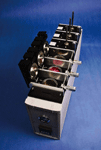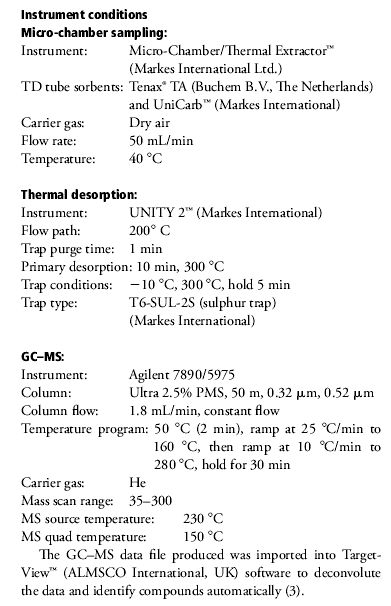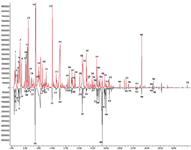Determining the Health Impact of Burning Mosquito Coils Using Versatile Micro-Chamber Sampling and TD-GC–MS
Burning mosquito coils to repel these pests is common in many countries; however the emission of various, potentially toxic volatile organic compounds (VOCs) is cause for concern.
Lara Kelly, Markes International, Ltd.
Burning mosquito coils to repel these pests is common in many countries; however the emission of various, potentially toxic volatile organic compounds (VOCs) is cause for concern. Novel sampling equipment with TD-GC–MS is used to extract, concentrate, and analyze the emissions of two burning coils and determine any potential impact on consumer health.
Mosquito coils are a form of incense whose active ingredients are usually derived from pyrethin, a natural insecticide. When burnt, the smoke repels, paralyses, or kills mosquitoes. These coils are very popular in Asia, Africa, and South America; however, there has been concern about levels and potential harm of chemicals emitted, e.g., polycyclic aromatic hydrocarbons (PAHs) or aldehydes (types of volatile organic compounds [VOCs] with known health effects), particularly when burned for long periods in confined or poorly ventilated areas (1). Two types of coil (one red, one black) were obtained and burnt, and their VOC emissions compared to estimate their safety.

Figure 1: A micro-chamber sampling unit with six individual chambers.
To analyze the emissions of a particular substance, novel micro-scale chamber equipment provides a compact, portable unit that allows fast screening of several samples, simultaneously (Figure 1) (2). For bulk emissions testing, a small amount of a sample is placed in the bottom of an individual chamber pot. Several pots can then be inserted into the micro-chamber unit set to a prescribed temperature. Emitted vapor is extracted and retained using sorbent tubes, and its VOC composition determined by GC(MS).
To obtain a comprehensive representation of the VOC emissions, thermal desorption of the extracted vapors was performed prior to GC–MS analysis. This well-established technique concentrates the VOCs from a large sample into a narrow band of vapor and efficiently injects this directly into the GC column, giving results with far higher sensitivity, therefore allowing more reliable compound identification.

Table I: Identification of VOCs found in mosquito coil emissions (* only found in red coil)
Experimental Conditions
Sections (~40 mm) of both red and black mosquito coils were cut and lit. These were then placed inside individual micro-chamber pots (constructed from inert-coated stainless steel), which were inserted into the micro-chamber sampling unit and sealed. The samples were left to equilibrate for 10 min under a constant flow of dry air (to ensure lit samples were not extinguished). A conditioned TD tube containing a combination of sorbents (allowing the retention of a broad range of analytes) was placed on the outlet port of each of the chambers, with a diffusion locking cap (Markes International Ltd., UK) on the nonsampling end to allow air flow and prevent contaminant ingress. The tubes were removed after 30 min.
Following sampling, the tubes were placed onto the TD system, desorbed, and then analyzed by GC–MS. Full conditions are listed below.

Results and Discussion
Figure 2 displays the VOC profiles of both the red and the black mosquito coils when burning. The complexity of the chromatograms gives an indication to the high chemical emissions and the efficiency of the extraction/concentration technique used. The differences between the two mosquito coils are visible; although there are many common compounds, these are often present in different abundances. TargetView, a deconvolution and identification software package, was used to automatically and quickly determine the identity of peaks in the complex data with high confidence (a match co-efficient exclusion value of >0.7 was used); these are listed in Table I. Compounds that are present in the red mosquito coil only are marked with an asterisk.
Some of the compounds found were nontoxic fragrance compounds. However, of concern, the most abundant compound emitted from the red coil, and a significant contributor to emissions of the black coil, is benzene, a known carcinogen and one linked to many serious health problems. The chromatograms also show that many other suspected carcinogens, e.g., furan, ethylbenzene, and naphthalene (which are categorized as IARC Group 2B carcinogens), or respiratory tract irritants, e.g., benzaldehyde, tridecane, and phenol, are observed in both but are more abundant in the red coil emissions. It is also interesting to note that allethrin, a synthetic pyrethroid (natural insecticide), is found only in the red coil emissions. In addition, the compound 2,3-butanedione, which is another mosquito repellent, is found at a significantly higher concentration in the red coil than the black.

Figure 2: Chromatograms of VOCs from red mosquito coil (upper) and black mosquito coil (lower; inverted).
Conclusion
The introduction of micro-chamber sampling technology has made in-house screening of product emissions far more accessible to manufacturers due to its simplicity, size, and speed.
Via this simple, yet efficient, method of chemical extraction and sample concentration for GC–MS analysis, comprehensive VOC profiles of both mosquito coils were obtained. The results suggest that though the red coil has significantly higher VOC emission levels, either coil would give cause for concern if burned for a prolonged duration in a poorly ventilated area.
References
(1) W. Liu, J. Zhang, J.H. Hashim, J. Jalaludin, Z. Hashim, and B.D. Goldstein. Environmental Health Perspectives 111(12): 1454–1460 (2003).
(2) Markes International TDTS 67: Introducing the Micro-Chamber/Thermal Extractor™ (µ-CTE™) for rapid screening of chemicals released (emitted) by products and materials.
(3) Markes International TDTS 90: Automatic detection of trace target compounds in complex chemical emission profiles.
Markes International, Ltd.

Gwaun Elai Medi Science Campus, Llantrisant CF72 8XL UK tel. + 44 (0) 1443 230935; fax + 44 (0) 1443 231531
Website: www.markes.com

Separation of Ultra-Short and Long Chain PFAS Compounds Using a Positive Charge Surface Column
December 11th 2024A separation of ultra-short and long chain PFAS (C1-C18) is performed on a HALO®PCS Phenyl-Hexyl column along with a HALO®PFAS Delay column which demonstrates excellent retention for both hydrophilic and hydrophobic analytes.















